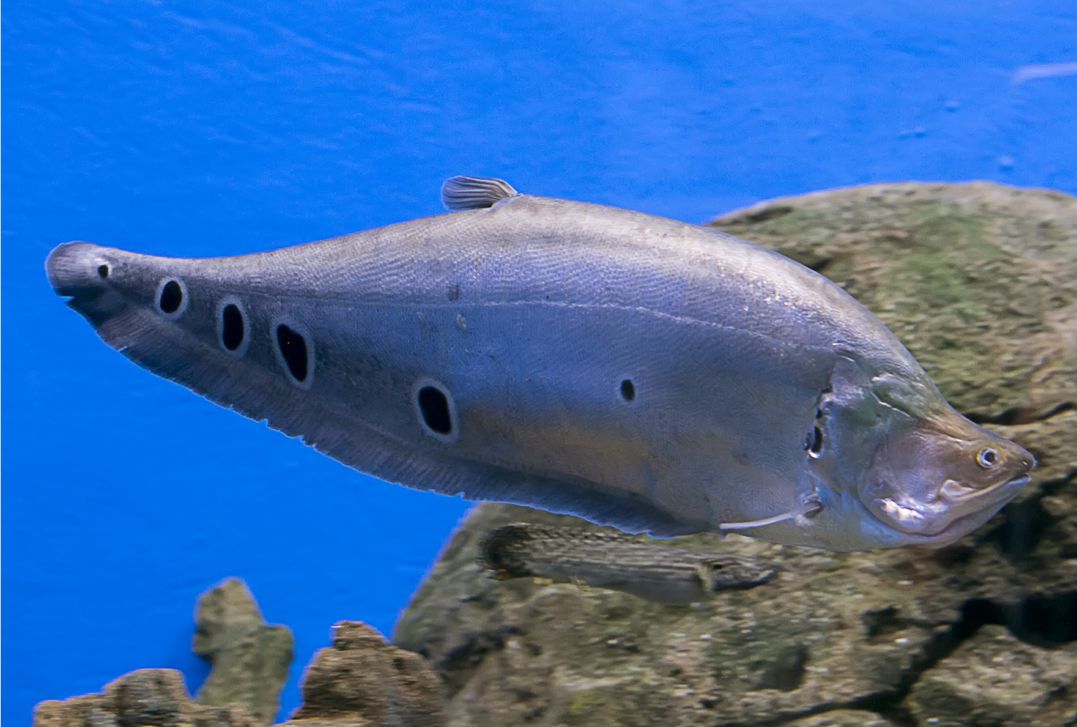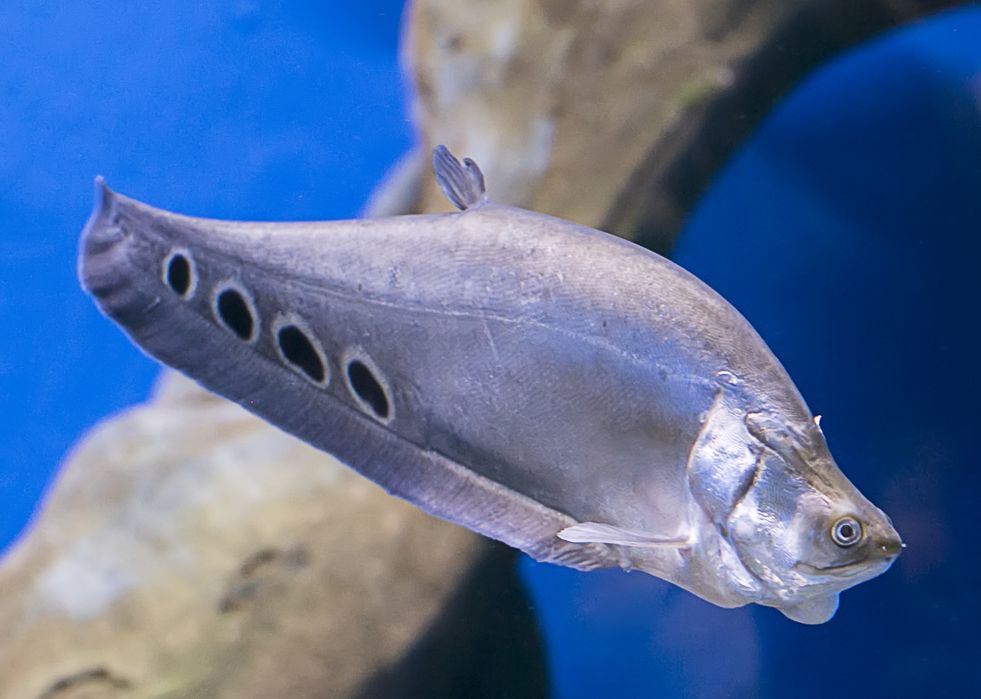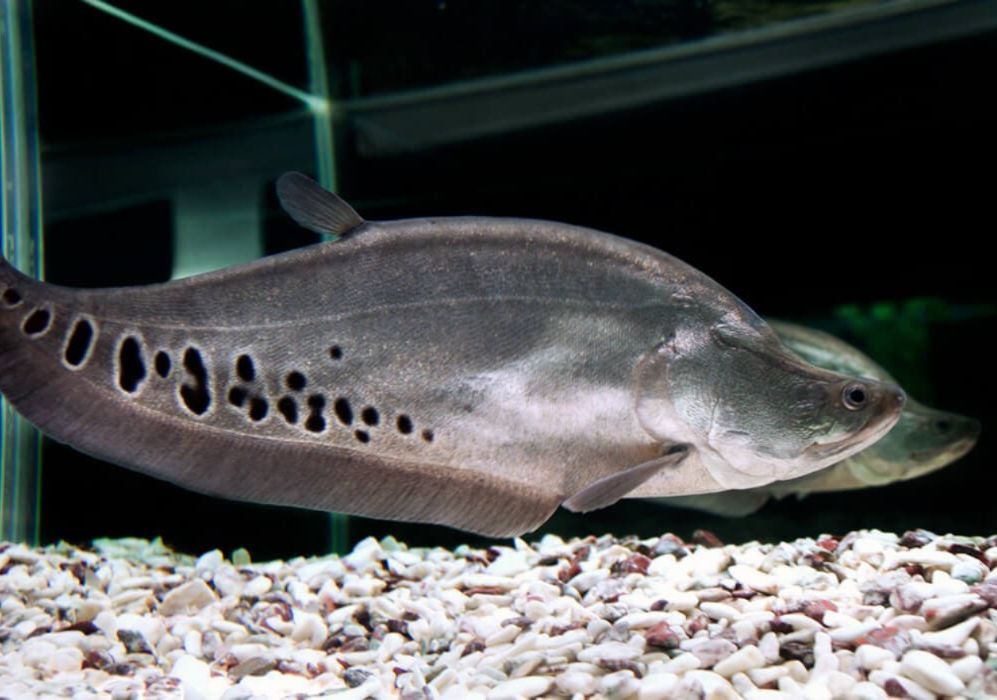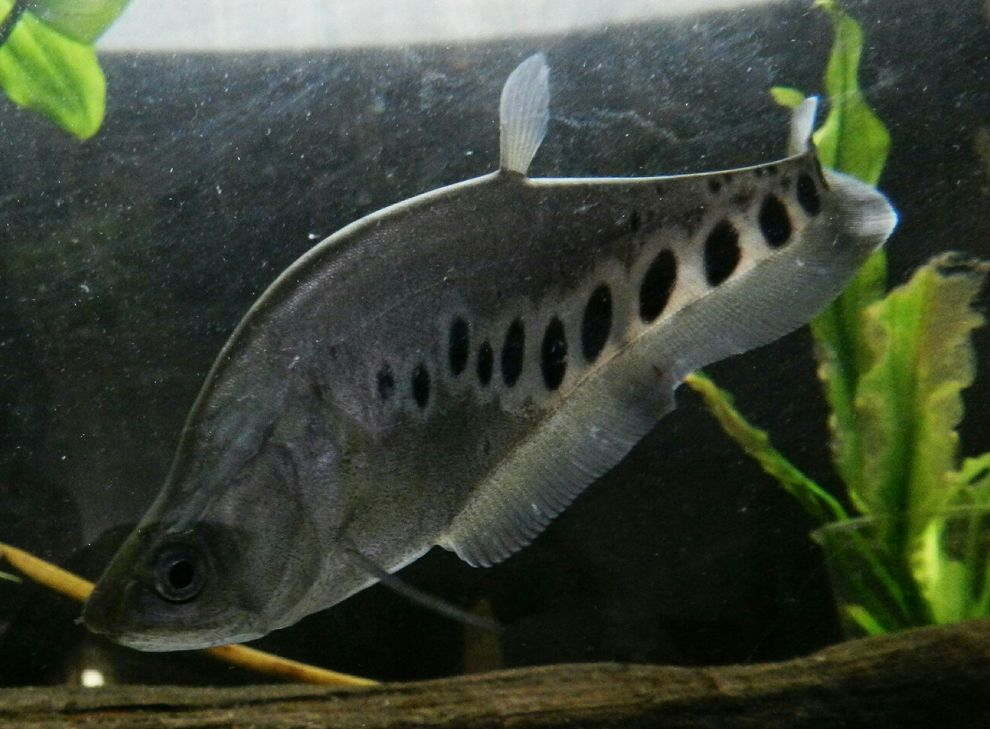Chitala ornata, commonly known as the Clown Knife Fish or Clown Featherback, is a popular freshwater fish species among aquarium enthusiasts. Is a large fish with an unusual body shape. The fish is kept in home aquaria due to its uncommon appearance. However, keeping this fish has some peculiarities about which you will find out from our article.

Contents
Habitat in the wild
In the wild clown knife fish inhabits large rivers located on the South and South-East of Asia, in Thailand, Cambodia and Vietnam. The fish dwells everywhere, it lives in main river bed of Mekong and Chao Phraya. The clown knife fish was introduced into other countries including the USA (Florida). The introduction of Chitala ornata in non-native habitats can have ecological impacts and is generally discouraged due to the potential for negative effects on native species and ecosystems. In the case of Florida, where Chitala ornata has been reported, it is considered an invasive species.
In the wild, Chitala ornata inhabits lakes, bogs, floodplains, backwaters of large rivers. They are typically found in slow-moving or standing water bodies with dense vegetation and submerged structures like fallen logs, tree roots, and aquatic plants. These structures provide hiding places and shelter for the fish. Their native habitats are characterized by dense vegetation, including submerged plants and floating vegetation. Clown Knife Fish are known to be skilled swimmers and can navigate through complex aquatic environments.
Young species gather into groups and hide among the aquatic plants and snags. The adult species are loners, they hunt from a hide by staying downstream among thickly growing plants.
Clown featherback is a nocturnal predator, that lives under roots of riverside trees and snags in slow, muddy and warm rivers and backwaters. It lies in the dark and waits for its prey in the hide. If fish is hungry, it will prey on any organism that it can swallow. Here we have to mention, that the fish is full of itself – it is capable of attacking fish that is just one forth smaller than clown knife fish.
Can you eat clown knife fish?
In its birthplace this fish is a commercial one and it is widely used as food. The clown featherback is commonly seen in the cuisine of Thailand and other Southeast Asian countries.
Description
Body
The clown knife fish has humpbacked elongated body flattened from sides with small scales; it has silvery-gray color. It has a row of round dark spots with white edging along its body, their number varies from 6 to 15. There is also an albino kind of the fish; Albino Clown Knife Fish have a pale, creamy-white or pinkish coloration due to the absence of melanin pigments in their skin, scales, and eyes. They lack the typical dark markings seen in the wild-type Clown Knife Fish.
Distinctive feature of the clown knife fish is that it can swim both forward and backward. The dorsal is so small that it rather resembles a small feather, than a fin. Things are quite the opposite as for the anal fin – it is rather long: it stretches starting from pectoral fins and smoothly transfers into the tail fin. The fin moves all the time, due to this the fish can swim.
Color
Anal fin of the young species has bright pattern on it, that consists of lots intersecting lines. The brighter is the pattern on the anal fin of rising fish species, the more pronounced and large spots on their body they will have when they become reproductive. Pectoral fins allow the fish to perform various moves when swimming.
Temper
Are clown knife fish aggressive?
Chitala ornata are generally considered to be semi-aggressive fish. Their level of aggression can vary depending on the individual fish, their size, and the tank setup. Clown Knife Fish can be territorial, especially as they mature. It is not recommended to keep multiple Clown Knife Fish in the same tank, as they can become aggressive towards each other and engage in territorial disputes.
Due to their predatory nature, Clown Knife Fish may view smaller fish as potential prey. They have a large mouth and can easily swallow fish that are smaller in size. It is important to avoid keeping small fish with Clown Knife Fish to prevent them from being eaten or stressed.
Teeth
Do clown knife fish have teeth?
Large mouth has many small teeth. They possess small, sharp teeth that are used for capturing and consuming their prey. Their teeth are located in both their upper and lower jaws.
Breathe
Do clown knife fish breathe air?
Yes, Chitala ornata possess a unique adaptation that allows them to breathe air. The fish respiratory organs are constructed so, that it can breathe with oxygen saturated in water and with atmospheric air. You can often see how you pet rises to the water surface to gasp an air bubble. This allows them to supplement their oxygen needs, particularly in environments with low oxygen levels or stagnant water.
Size
How big do clown knife fish get?
Clown Knife Fish (Chitala ornata) can grow quite large, reaching impressive sizes. In the wild clown knife fish length may reach 1 m (3.3 ft). It’s important to note that this size is not commonly achieved in most home aquariums due to space limitations and the challenges of providing the ideal conditions for their growth. However at tank conditions it grows smaller, they often reach sizes between 12 and 24 inches (30-60 cm) over several years.
Growth rate
How fast do clown knife fish grow?
During the first year, Clown Knife Fish can grow several inches in length if provided with a nutritious diet and suitable living conditions. However, as they approach adulthood, their growth rate tends to slow down. It is not uncommon for Clown Knife Fish to take several years to reach their maximum potential size.
It’s crucial to provide Clown Knife Fish with a sufficiently large tank and appropriate care to support their growth and overall well-being. Their tank should be spacious enough to accommodate their potential size and provide ample swimming space. Regular maintenance, proper nutrition, and ideal water conditions contribute to their growth potential.
Lifespan
How long do clown knife fish live?
Chitala ornata have the potential for a relatively long lifespan if provided with proper care and suitable living conditions. In captivity, Clown Knife Fish can live for around 10 to 15 years on average. However, with exceptional care and optimal conditions, some individuals have been known to live even longer, reaching 20 years or more.
| Characteristic | Description |
|---|---|
| Scientific Name | Chitala ornata |
| Common Names | Clown Featherback, Clown Knife Fish, spotted knifefish |
| Origin | Southeast Asia (Thailand, Cambodia, Laos, Vietnam) |
| Size | Can grow up to 3 feet (90 cm) in length |
| Lifespan | Around 10-15 years in captivity |
| Appearance | Elongated body with a silver or grayish color |
| Temperament | Generally peaceful, but can be territorial |
| Compatibility | May eat smaller fish that can fit in their mouth |
| Preferred Habitat | Slow-moving rivers, floodplains, and standing water |
| Water Parameters | Temperature: 75-82°F (24-28°C), pH: 6.5-7.5 |
| Diet | Carnivorous. Feeds on live or frozen meaty foods. Accepts high-quality pellets and flakes as supplements. |
| Tank Requirements | Large aquarium of at least 200 gallons. Provide ample swimming space and hiding spots |
| Breeding | Difficult to breed in captivity. Requires specific conditions and spawning triggers |
| Conservation Status | Not evaluated (IUCN) |

Difficulties in keeping
This fish is challenging in terms of keeping. For this reason it can’t be recommended for beginners – you will need a tank with balanced environment and at least some experience.

Keeping in a tank
Tank size
Large size of the clown knife fish implies having specialized and very large tank. As for the recommended tank volume – this is a controversial issue. On one hand, the fish can grow up to 1 meter long, on the other hand – it seldom becomes that large in a tank.
Anyway, the tank size for a Clown Featherback should be a minimum of 200 gallons (757 liters) or more. However, ideally it has to be twice as large. Providing a larger tank will offer ample swimming space and help mimic their natural habitat.
Water parameters
The recommended water temperature range for Clown Knife Fish is typically between 75°F (24°C) and 82°F (28°C). Hardness – up to 10 °, pH 6.0–7.0. It is important to have aeration and filtration in the tank as well as weekly renew of 30% of tank water.
Filter
Powerful external filter is a must as well as moderately strong water flow in the tank. It is better to use external filter with UF-sterilizer, since the fish is very sensitive to medicines and in this case prevention is the best idea. Besides this, clown knife fish produces a lot of waste and feeds on protein food, its leftovers spoil the tank water very quickly.
Tank decor
To make sure that the fish will live long and happy life, create it a tank with clean water, moderate water flow and lots of shelters.
As for the tank plants, you should put them along side and back walls of the tank to leave the fish a place to swim as well as shelters to hide. The thing is that all species are active at night. During the day they try to hide under snags or among the plants and come out when it is getting dark.
Caves, snags, thickly planted tank plants – all these will do as shelters for the fish. It is timid and if there is no place to hide in a tank during the day, they will be constantly stressed and try to hide in some dark places in a tank. As for the open areas in the tank, it’s better to shadow them by means of floating plants.
Clown knife fish spends most of its time in middle or bottom water layers of the tank, but sometimes it can rise to water surface to gasp some air or get some food.

Diet
This is a predator. It feeds on small fishes, crustaceans and other spineless species.
In a tank the fish eats live food. For example, you can feed the young fish with feeder fish (guppies, goldfish, or minnows), earthworms, brine shrimp, krill, and bloodworms. These foods provide the essential proteins and nutrients they need. As for the adult species, you can feed them with some whole prawns, large earthworms.
Clown knife fish are quite picky and may refuse eating the food you give them, you may also see how the adult species refuse taking the food they ate eagerly some time earlier. In addition to live or frozen foods, you can supplement their diet with high-quality pellets or flakes specifically formulated for carnivorous fish. Look for products that contain a high percentage of animal proteins and are suitable for predatory fish.
Tank mates
As we’ve mentioned above clown knife fish is a predator that demonstrates aggression not only towards other species, but towards its kind as well.
It is better to keep such pets in singles or with tank fishes of similar size. The clown knife fish is peaceful towards large sized fish species, those the fish is sure it won’t be able to swallow. Therefore, possible tank mates can be the following: pleco, bala shark, arowana, giant gourami, iridescent shark, sailfin pleco and so on.
It is not recommended to keep the fish with aggressive cichlids (flowerhorn, red terror), since despite the fish is aggressive, it is timid at the same time. We strongly recommend not to keep two males of this fish kind in one tank, since when they fight, they harm each other quite seriously.
Gender differences: male vs female
Males have large, but slim body if compared with that of the females. The latter have more rounded abdomen during the spawning period.
Breeding
Clown knife fish spawning in captivity is possible, but it happens very seldom because for successful breeding the fish requires a very large tank.
By the age of three years old the clown knife fish becomes reproductive. Put the fish into a separate tank of large volume to breed. There should be shelters and flat stones on its bottom as well as some floating plants on the water surface.
One female lays about 2-10 thousand of large yellowish eggs on floating plants. As for the proper tank water parameters, they are the following: water temperature 26–28 °C, hardness – до 5 °, pH – 6,0–6,5. During the egg stage that lasts almost for a week the male takes care of the future offspring: he guards and cleans the eggs from settling organic waste.
Except this, the male provides flaw of water to the eggs by waving its tail fin. Once the juveniles hatch, you have to put them into a nursery tank right away. Brine shrimp nauplii can be used as start food for juveniles.